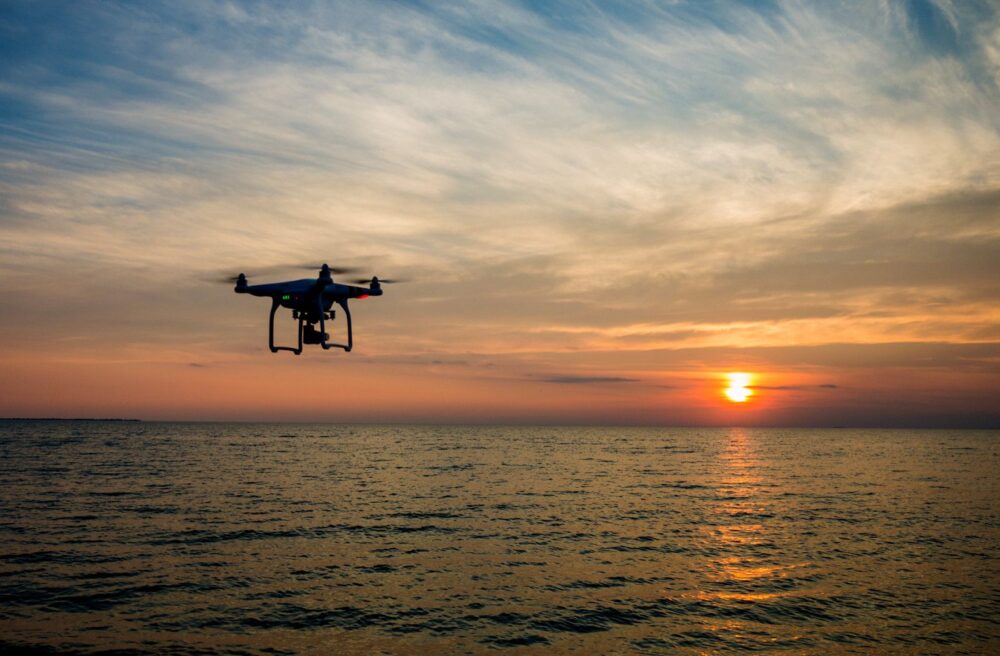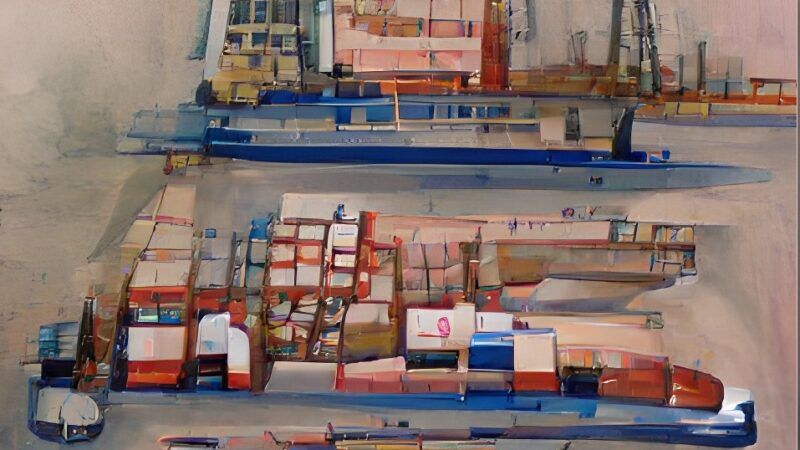 The uses of drone technology in port management are still in the trial phase. [Image by Aaron Burden]
The uses of drone technology in port management are still in the trial phase. [Image by Aaron Burden]
Air drones for port management: effective tool or unnecessary risk?
Are air drones a tool that should be part of any Smart Port? Although this technology offers interesting advantages for oversight and surveillance of facilities, it also poses significant security challenges. On PierNext, we’re looking at how they are most commonly used today and how they can be used at ports.
 The uses of drone technology in port management are still in the trial phase. [Image by Aaron Burden]
The uses of drone technology in port management are still in the trial phase. [Image by Aaron Burden]
Drones, unmanned aerial vehicles of various sizes and characteristics, have become very popular in recent years for entertainment as well as audiovisual uses. However, these small planes and multi-copters can provide all sorts of data from hard-to-reach places, which means they can be used for countless applications.
Jordi Santacana is one of the top experts in these devices in Spain. “A drone is an aircraft that leaves its pilot on the ground. As a result, the device can be smaller, lighter and more affordable. And it can be used for numerous purposes without putting the pilot at risk,” explains Santacana from the BCN Drone Center, the ‘test circuit’ for these vehicles that he heads up.
Santacana describes the two most common types of drones. On the one hand, we have fixed-wing drones (which look like a conventional airplane) and, on the other, multi-copters. The latter are more manoeuvrable in small spaces and can hover. The former, however, have greater autonomy. The important part of a drone, however, isn’t the vehicle itself but the information collected using the sensors mounted on it. “The most important characteristic of a drone is that it allows us to collect data more easily or in places that people can’t get to,” clarifies Santacana.
Drones, efficient ‘sensor-transport’ vehicles
It is this data, precisely, that is most important in the less recreational uses of drones. Santacana highlights the ones with conventional cameras and those with other sensors that can ‘see more than the human eye’, from infrared cameras and thermal imaging (mapping the temperature of objects at a distance) to sensors that detect temperature, humidity or air pollution and microparticles.
Being able to act as a ‘sensor taxi’ is what makes them particularly interesting for industrial or power facilities, which have embraced this technology for more precise, safer inspections. This is the work of, for example, MDrone, a company that offers technical services using drones to collect data. So, one of the most common jobs is inspecting high-voltage towers. “Traditionally, high-voltage towers, for example, were inspected by an operator, who cut the line and did a physical inspection,” explains Marcel Robustier, co-founder and CEO of MDrone. “Now it is no longer necessary to cut power to the lines and the operator stays on the ground, where it is safer.” Because Robustier believes this technology can’t replace people: “Quite the contrary, it helps them do their job more safely and efficiently. But their experience is still crucial.”
Being able to act as a ‘sensor taxi’ is what makes them particularly interesting for industrial or power facilities, which have embraced this technology for more precise, safer inspections.
Inspecting industrial facilities, the most common use
MDrone, over its five-year history, has specialised “in monitoring and supervising large power facilities, high- and medium-voltage networks, communication towers and viaducts.” In most cases, they use a conventional video camera with thermal imaging (which detects the infrared radiation given off to determine temperatures at a great distance). “This allows us to detect ‘hotspots’, which means we can find anomalies and problems that aren’t visible to the human eye,” continues Robustier.
If anyone knows about thermal imaging, it is Aniol Ribot. He and his team at Apliter are experts in this technology, which for most projects is installed on drones. “This technique allows us to take ‘snapshots’ of the temperatures in a specific environment. This makes it an interesting tool for managing and overseeing areas where temperature changes can indicate risk.” Drones with thermal imaging cameras are also used “to rescue people lost in the mountains or after a shipwreck, for example. As they are fast, agile devices, they can help in high-risk situations when people’s lives are at stake,” explains Ribot. However, Apliter also specialises in applications for industry, “such as checking power, gas, heating or cooling facilities.” In addition to these inspections, Hemav also puts multi-spectrum cameras on its drones. They not only capture the spectrum visible to the human eye, but also take pictures at the infrared and near infrared spectrum. “With this information, we can work on projects for precision agriculture, providing recommendations for irrigation and fertilisation, or detecting pests in the crops. In fact, our data can be used to make predictive models of the harvest,” explains Javier Muñoz, the company’s data processing manager.
Thermography allows us to take ‘snapshots’ of the temperatures in a specific environment. This makes it an interesting tool for managing and overseeing areas where temperature changes can indicate risk
How can they be used for port management?
Muñoz is the first to respond to the question because, in fact, he is speaking from experience. Although not with his current team at Hemav, he did work on the project to create an orthophoto of the Port of Barcelona, which in addition to being visually spectacular was also the basis for the map currently in use. And because he knows the area, Muñoz is able to make a preliminary diagnosis. “Ports in general, not just the Port of Barcelona, pose many conflicts due to their location, near the city and often near the airport.” The current regulatory framework, from December 2017 with more recent updates, opens the doors to new uses that were previously limited (such as night flights, use in urban settings, crowds of people, or the port airspace), although it requires specific authorisation for each use and the administration’s response time so far has been slow and applications are often rejected, according to those we interviewed. “At Hemav, we have applied for some permits, for example to study the movement of the cement blocks on the breakwaters. With a drone and a high-density model, this would be relatively easy to do. However, it is in the same area as the approach to the airport. Although flight altitude is capped at 120 m above the ground and planes fly quite a bit higher, for now it can’t be done,” explains Muñoz.
For his part, Aniol Ribot recommends using thermal imaging to monitor for and manage any gas leaks that may occur. “This would be done with special cameras, called Gas Find IR. This would allow us to monitor the facilities or detect a gas leak safely and precisely, above all with large storage tanks like the ones at the port. Perimeter surveillance could also be done using a conventional thermal imaging camera.” For his part, Muñoz also believes in “monitoring containers with drones. The drone would fly over the container area once every eight hours, instantly providing data on the real movement of containers each day. It would be a reoccurring flight that could even be automated,” he continues. “In fact, the possibilities are nearly endless, but legal restrictions are very tight for the moment,” this professional regrets.
Right now, in the United States work is under way to develop a system that uses drones to deliver replacement parts to ships in remote areas. This is the ground-breaking experience of the company Wilhelmsen Ships Service, which operates in more than 2,200 ports in 125 countries and, for the moment, is working on a pilot programme. The Port of Singapore, in fact, has launched a similar system to deliver small cargo loads. The Abu Dhabi Port Authority uses this type of technology at the Port of Khalifa as part of their security system. However, in Europe, so far, we’ve let the risks overshadow the opportunities. This is the case at the Port of Rotterdam, where strict rules have been imposed on the use of drones to prevent ‘the less friendly uses’ for this technology, such as espionage and surveillance for criminal activity, as explains a recent article in the Port Technology journal.
And, in light of recent incidents at Gatwick Airport, it is clear that the possibilities for using them and ensuring basic safety are at odds when we are talking about drones and transporting cargo and people. Perhaps this is why progress has been quite slow in any country using drones for port management. At least for now.



![The drones could be used for the inspection of large facilities in the ports [Image by James Strong]](https://piernext.portdebarcelona.cat/wp-content/uploads/2019/01/aerial-blue-sky-drone-67699-1024x572.jpg)



